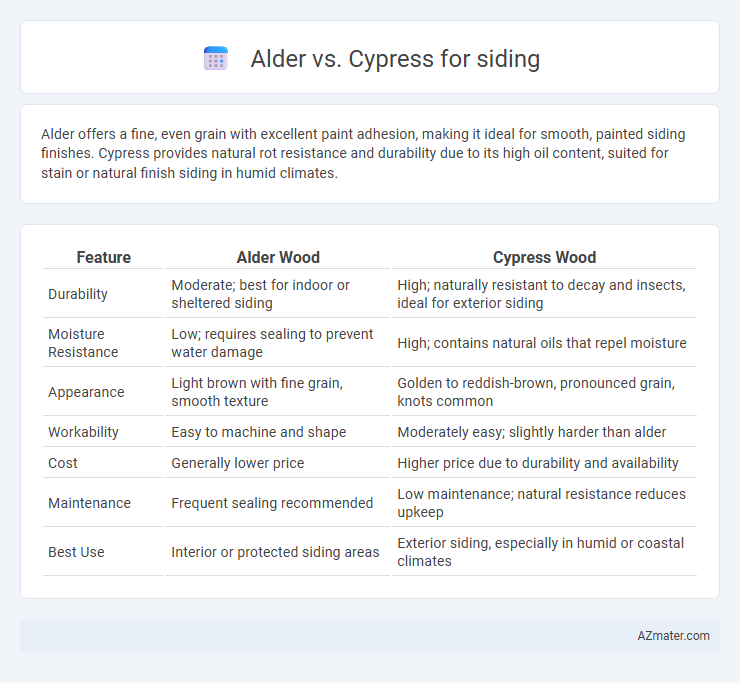Alder offers a fine, even grain with excellent paint adhesion, making it ideal for smooth, painted siding finishes. Cypress provides natural rot resistance and durability due to its high oil content, suited for stain or natural finish siding in humid climates.
Table of Comparison
| Feature | Alder Wood | Cypress Wood |
|---|---|---|
| Durability | Moderate; best for indoor or sheltered siding | High; naturally resistant to decay and insects, ideal for exterior siding |
| Moisture Resistance | Low; requires sealing to prevent water damage | High; contains natural oils that repel moisture |
| Appearance | Light brown with fine grain, smooth texture | Golden to reddish-brown, pronounced grain, knots common |
| Workability | Easy to machine and shape | Moderately easy; slightly harder than alder |
| Cost | Generally lower price | Higher price due to durability and availability |
| Maintenance | Frequent sealing recommended | Low maintenance; natural resistance reduces upkeep |
| Best Use | Interior or protected siding areas | Exterior siding, especially in humid or coastal climates |
Introduction to Alder and Cypress Siding
Alder and Cypress siding each offer unique benefits for exterior cladding, with Alder known for its fine, uniform texture and warm reddish-brown tones that enhance curb appeal. Cypress siding stands out for its natural resistance to rot and insects, making it a durable and low-maintenance option, especially in humid climates. Both wood types provide excellent workability and a smooth finish, allowing for seamless painting or staining to suit various architectural styles.
Key Characteristics of Alder Wood
Alder wood, known for its moderate hardness and fine, even grain, offers a smooth surface ideal for siding applications requiring easy staining and finishing. Its natural resistance to decay is lower compared to cypress, making it more suitable for interior or covered exterior siding where moisture exposure is minimal. Alder's warm reddish-brown color enhances architectural aesthetics but demands regular maintenance to preserve its appearance against weathering.
Distinct Features of Cypress Wood
Cypress wood is known for its natural resistance to decay and insects, making it an excellent choice for siding in humid or coastal environments. Its distinctive tight grain and warm golden to amber hues provide a visually appealing, durable surface that ages gracefully over time. Unlike alder, cypress offers enhanced dimensional stability and weather resistance, ensuring lower maintenance and longer-lasting exterior protection.
Durability: Alder vs Cypress
Cypress siding is renowned for its superior durability, resisting rot, insects, and harsh weather better than alder, making it ideal for exterior applications. Alder wood, while aesthetically pleasing with its smooth grain, tends to be softer and more prone to dents, decay, and insect damage, reducing its longevity as siding. For long-term performance and minimal maintenance, cypress offers a more resilient choice over alder in siding projects.
Weather Resistance and Longevity
Cypress siding offers superior weather resistance compared to alder due to its natural oils that repel moisture and resist decay, making it ideal for humid or coastal climates. Alder tends to absorb moisture more readily, leading to faster deterioration and limited longevity when exposed to harsh weather conditions. Cypress's durability and resistance to insect damage contribute to a significantly longer lifespan, often exceeding 30 years with proper maintenance, whereas alder siding typically requires more frequent replacement and upkeep.
Maintenance Requirements
Alder siding requires regular sealing and staining due to its softer wood composition, which makes it more susceptible to dents and moisture damage, increasing maintenance frequency. Cypress siding offers natural resistance to rot, decay, and insects because of its high oil content, reducing the need for frequent treatments and making it a low-maintenance option. Homeowners seeking durability with less upkeep often prefer cypress for siding over alder, especially in humid or coastal environments.
Aesthetic Appeal and Color Variations
Alder wood offers a warm, rich reddish-brown hue with fine grain patterns that enhance the natural aesthetic appeal of siding, making it ideal for traditional and rustic architectural styles. Cypress siding stands out with its natural resistance to decay and distinctive pale yellow to amber tones, providing a versatile color palette that weathers to a soft gray over time, perfect for coastal and historic homes. Both wood types offer unique color variations that allow homeowners to choose siding that complements diverse exterior designs and color schemes.
Sustainability and Environmental Impact
Alder wood is known for its rapid growth rate and lower environmental footprint, making it a more sustainable choice for siding compared to cypress, which grows slower and requires more resources. Cypress contains natural oils that enhance durability and resistance to decay, reducing the need for chemical treatments, but harvesting cypress can contribute to wetland habitat disruption. Sustainable sourcing certifications like FSC are crucial in evaluating the true environmental impact of both woods when used for siding.
Cost Comparison: Alder and Cypress Siding
Alder siding generally costs less than cypress siding, with alder priced around $3 to $6 per square foot compared to cypress, which ranges from $5 to $8 per square foot. Labor costs for installation on both woods are similar, but cypress's higher durability and decay resistance can reduce long-term maintenance expenses. Choosing alder siding can offer budget-friendly upfront costs, while cypress siding provides a longer lifespan and potentially lower repair costs over time.
Choosing the Right Wood for Your Siding
When selecting wood for siding, alder offers a smooth texture and consistent grain, making it ideal for painted finishes and environments with moderate moisture. Cypress boasts natural decay resistance and rich, warm tones, providing durability and aesthetic appeal in humid or coastal climates. Choosing between alder and cypress depends on your climate exposure and whether you prefer a painted or stained finish to enhance your home's exterior longevity and beauty.

Infographic: Alder vs Cypress for Siding
 azmater.com
azmater.com